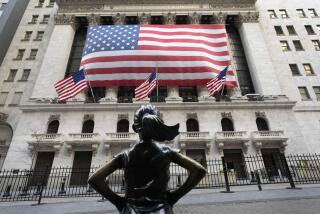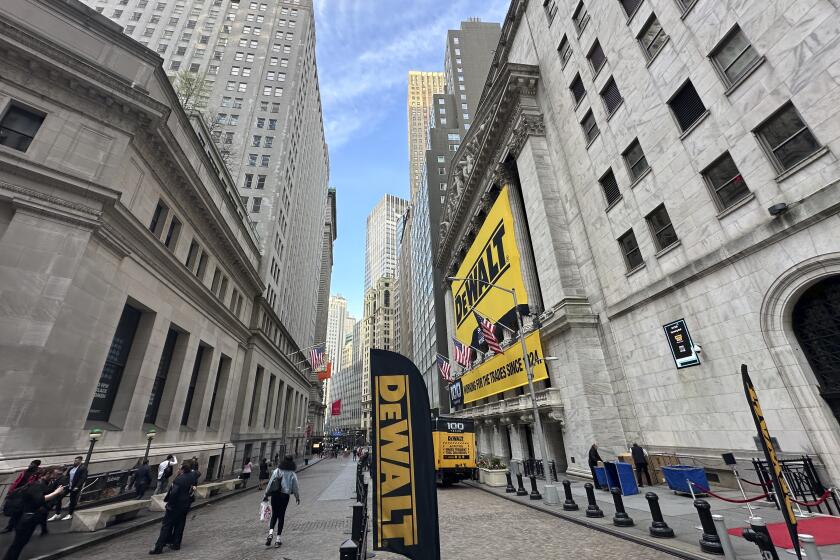Stock traders face a brutal 72 hours, caught in a Trump-Powell squeeze

It’s not that stock traders exactly knew that President Trump was going to lash out at China on Thursday. But some sensed something might be coming.
From the moment Federal Reserve Chairman Jerome Powell said on Wednesday that trade tensions had returned to just a “simmer,” they feared something like the tariff tweet that Trump ultimately delivered. “They were holding the ‘simmering’ comment in their heads,” said Kim Forrest, chief investment officer at Bokeh Capital Management in Pittsburgh.
The word implied Powell was somewhat sanguine about U.S.-China trade talks, which in turn helped explain his reluctance to commit to the additional interest-rate cuts that Trump so desperately wants. So, the thinking went, Trump would need to do something to prove to the Fed chief that those talks aren’t going well at all and that the global economy remains in grave danger.
It’s hard to know, of course, if such thoughts went through Trump’s mind. Whatever the case, traders reacted predictably. The Dow Jones industrial average swung from a 300-point gain to a 280-point loss Thursday. The index was down another 172 points shortly before noon Pacific time on Friday, before recovering somewhat to close down 98. That marked the fifth straight losing session and the worst week since December 2018.
“The heat has been turned up,” Forrest said. “When does it get to a boil?”
Maybe Trump’s threats and the Fed are unrelated. But traders were having a hard time swallowing that. Instead, they fixated on a timeline in which Powell seems to suggest cooling trade tensions reduced the need for future rate reductions — and a day later Trump revs them back up. It fits the pattern of a president bent on getting the central bank to submit, many thought.
“Powell was very careful to say that he was looking at three things, one of which was global growth and the extent to which that is risked by trade tensions,” said Ellen Hazen, senior vice president and portfolio manager for F.L. Putnam, which has $2.2 billion under management. “It’s very logical to conclude that if trade tensions increase, given what Powell said, that would be something he would look at to evaluate a further cut.”
“After getting only a measly 25 basis-point rate cut from the Fed, President Trump decided to ratchet up the trade war with China,” wrote Greg Valliere of AGF Investments. Trump’s “message to the Fed was clear — I’ll make sure that trade will be a major economic headwind for months to come, so you’d better cut rates further.”
While Trump on Thursday continued to insist China was paying the cost of his tariffs, CEOs have in earnings calls over the last few weeks repeatedly detailed the rising direct and indirect costs to their businesses. The effects of his trade wars on the manufacturing sector are growing increasingly evident. A few hours before Trump announced his tariffs, the Institute of Supply Management released its July factory gauge showing its fourth straight decline and its worst result since 2016.
“If the president’s goal is to bring manufacturing back to the United States, then doubling down on tariffs makes about as much sense as bowling cleats,” said Kip Eideberg of the Assn. of Equipment Manufacturers. “At the end of the day this means smaller profits, selective price increases, and supply chains moving from China to countries such as Vietnam and Mexico. It does not mean more American manufacturing jobs.”
Compared with inflation and employment, trade offers Trump an immediate lever to affect the economic outlook. Whatever the truth, the result has been the shattering of calm in markets that had until this week been skating fairly placidly. It had been two months since the S&P 500 fell more than 1%, a streak that ended Wednesday. The Cboe Volatility Index jumped from around 12 to almost 18 in four sessions.
All of it made for a brutal 72 hours for investors who had hoped to celebrate the Fed’s first easing since 2008.
“I don’t think it’s a coincidence the [tariffs] announcement came after the rate cut,” said Federated Investors fund manager Steve Chiavarone — who also sees it as a brilliant ploy. “It’s possible that while most folks were playing checkers, the president was playing three-dimensional chess here. And if he is, kudos to him.”
Powell’s refusal to commit to a full-blown rate cycle wasn’t sitting well with bulls to begin with. Many had been hoping for a half-point cut on Wednesday and were sorry to get only a quarter. They were happy when the market bounced back Thursday, seemingly on its own volition. Happy but worried.
“That ‘mid-cycle’ comment wasn’t what Trump wanted, so yes, I did expect something like this to happen,” said Yousef Abbasi, director of U.S. institutional equities and global market strategist at INTL FCStone. “Powell has a very thankless job because of Trump. Jay Powell and Trump: It’s like having a very demanding parent that sees everything you do as wrong.”
Now one question for stock investors is how much of a cushion will come from expectations for a more aggressive Fed. The rates market has been recalibrating quickly. Two-year Treasury yields were down about 14 basis points since the Wednesday close, at 1.73% as of 11:44 a.m. Pacific time Friday.
Matt Maley, an equity strategist at Miller Tabak + Co., had a more practical dilemma. After worrying for a while that the July Fed meeting would complicate his plans to go on vacation next week, he’s decided to keep to his schedule but leave time for checking in.
“Now I am like, ‘OK, I see now, how it affected Trump and he affected the markets,”’ Maley said. “I thought it would be a quiet vacation. Now I’ll be logging in to see what’s going on.”






